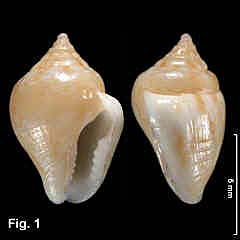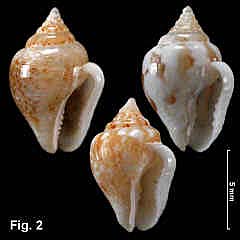|
|
|
|
|
Euplica poecila (Sowerby, 1844) Description: Shell solid, spire markedly concave in outline, whorls rounded, aperture half total shell length. Whorls weakly or, rarely, strongly nodulose. Spiral sculpture of flat cords on lower half of body whorl, sometimes extending up to shoulder. Outer lip straight or weakly sinuous in profile, with shallow sinus posteriorly except in very mature shells, thickened along whole length externally; thickened internally and with 7-10 denticles. Columella callus sharp edged, with 3-6 denticles on outer edge, and 2 plaits separated by a groove internally. Anterior canal not upturned, notch shallow. Colour variable; NSW shells fawn, flecked with brown and white, often with white spiral bands at shoulder and mid-body, and irregular brown axial bands. Interior white, columella occasionally patched with purple. Size: Up to 11 mm in length. Distribution: Indo-West Pacific; in Australia, known from Capricorn Group, Queensland, southwards to Sydney, NSW. Habitat: Most specimens are empty beach shells; one record live 18-30 m. Uncommon. Comparison: This species has some similarities to weakly sculptured specimens of Euplica varians, but in that species there are spiral ribs on the body whorl and nodules on the spire, but it is wider, and the aperture is more inclined to the shell axis. It is similar to the tropical species Euplica deshayesii which is larger and smoother. Synonymy: Cernohorsky (1972) considered E. poecila to be a synonym of E. varians, but now that more specimens are available the differences are constant. References by Wilson (1994), and Iredale & McMichael (1962) to Pyrene deshayesii in NSW are probably to E. poecila. Remarks: The specimens shown in Fig. 2 on this page were collected at Hastings Point together with those shown in Fig. 2 of E. varians. Fig. 1 Kurnell, Botany Bay, NSW (C.374101) Fig. 2 All from Hastings Point, NSW (C.207156) |

